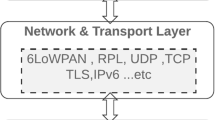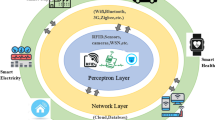Abstract
Mobile peer-to-peer networking (MP2P) is a relatively new paradigm compared to other wireless network technologies. In the last 10–15 years, it has gained tremendous popularity because of its usefulness in applications such as file sharing over the Internet in a decentralized manner. Security of mobile P2P networks represents an open research topic and a main challenge regarding the vulnerability of these networks and their convenience to different security attacks such as black hole, Sybil, etc. In this work, we analyze the black hole attack in wireless P2P networks using the AODV as the routing protocol. In a black hole attack, a malicious node assumes the identity of a legitimate node, by creating forged answers with a higher sequence number, and thus forces the victim node to prioritize it as a relay node. We propose a solution based on a modification of the AODV routing protocol, taking into account the behavior of each node participating in the network. The performances of our proposal are evaluated by simulation.

















Similar content being viewed by others
References
Y. Challal, Sécurité de l’Internet des Objets: Vers Une Approche Cognitive et Systémique des Réseaux et Télécommunications. Université de Technologie de Compiègne, 2012.
B. Wu, et al., A Survey on Attacks and Countermeasures in Mobile Ad Hoc Networks, Department of Computer Science and Engineering, Florida Atlantic University, SpringerBerlin, 2006.
D. Alexandre and E. Samuel, Peet-to-Peer, Master Professionnel, Système Informatique et Réseaux, Université Claude Bernard, Lyon, 2007.
A. Benoit, Algorithmique des Réseaux et des Télécoms, Chapitre 2: Réseaux Pair-à-Pair. ENS Lyon, 2006.
G. Pujolle, Les Réseaux, EYROLLESParis, 2008.
R. Al King, Localisation de Sources de Données et Optimisation de Requêtes Réparties en Environnement Pair-à-Pair. Thèse de Doctorat, Université de Toulouse, 2010.
Y. Huang and W. Lee, Attack analysis and detection for ad hoc routing protocols. In Proceedings of 7th International Symposium on Recent Advances in Intrusion Detection (RAID). Springer, 2004.
A. Esnault, Systèmes Pair-à-Pair pour l’Informatique Opportuniste. Réseaux et Télécommunications, Université de Bretagne Sud, 2017.
A. Hajami, Sécurité du Routage dans les Réseaux sans Fil Spontanés. Thèse de Doctorat, Université Mohammed V Souissi, Maroc, 2011.
N. Tabbane, S. Tabbane and A. Mehaoua, Simulation et Mésure des Performances du Protocole de Routage AODV. JTEA 2004, Hamamet, Tunisie, 2004.
Abdellaoui Rachid and Jean-Marc Robert, SUOLSR: A New Solution to Thwart Attacks Against the OLSR Protocol, Ecole de Technologie SupérieureMontreal, 2009.
P. Ning and K. Sun, How to misuse AODV: A case study of insider attacks against mobile ad hoc routing protocols. In Proceedings of IEEE Systems, Man and Cybernetics Society, Information Assurance Workshop (IAW’03). IEEE, June 2003.
M. A. Ayachi, Contributions à la Détection des Comportements Malhonnêtes dans les Réseaux Ad Hoc AODV par Analyse de la Confiance Implicite. Thèse de Doctorat, Université de Rennes 1, 2011.
D. Raffo, Security Schemes for the OLSR Protocol for Ad Hoc Networks. Ph.D. Thesis, Université de Paris, 2005.
Maha Abdelhaq, et al., Security routing mechanism for black hole attack over AODV MANET routing protocol, Australian Journal of Basic and Applied Sciences, Vol. 5, No. 10, pp. 1137–1145, 2011.
K. Lakshmi, et al., Modified AODV protocol against black hole attacks in MANET, International Journal of Engineering and Technology, Vol. 2, No. 6, pp. 444–449, 2010.
H. Deng, W. Li and D. P. Agrawal, Routing security in wireless ad hoc networks. Communications Magazine, IEEE, October 2002.
M. Al-Shurman, S. Yoo, and S. Park, Black hole attack in mobile ad hoc networks. In ACM Southeast Regional Conference, 2004.
L. Tamilselvan and V. Sankaranarayanan, Prevention of black hole attack in MANET. In The 2nd International Conference on Wireless Broadband and Ultra Wideband Communications, Aus Wireless, 2007.
L. Himral, V. Vig, and N. Chand, Preventing AODV routing protocol from black hole attack, International Journal of Engineering Science and Technology (IJEST), Vol.3, No. 5, pp. 3927–3932, 2011.
P. N. Raj and P. B. Swadas, DPRAODV: A dynamic learning system against black hole attack in AODV-based MANET, IJCSI International Journal of Computer Science Issues, Vol. 2, pp. 54–59, 2009.
S. C. Mandhata and S. N. Patro, A counter measure to black hole attack on AODV-based mobile ad-hoc networks, International Journal of Computer and Communication Technology (IJCCT), Vol. 2, No. VI, pp. 37–42, 2011.
S. V. Mallapur and S. R. Patil, Survey on simulation tools for mobile ad-hoc networks, International Journal of Computer Networks and Wireless Communication, Vol. 2, No. 2, pp. 241–248, 2012.
V. Legrand and S. Ubda, Vers un Modèle de Confiance pour les Objets Communicants: Une Approche Sociale, Laboratoire CITI INRIA ARES, 2004.
N. Kalia and H. Sharma, Detection of multiple black hole nodes attack in MANET by modifying the AODV protocol, Lovely Professional University PhagwaraPunjab, 2016.
F. J. Ros and P. M. Ruiz, Implementing a New Manet Unicast Routing Protocol in ns-2, Dept. of Information and Communication Engineering, University of MurciaMurcia, 2004.
K. Fall and K. Varadhan, The ns Manual, University of CaliforniaBerkeley, 2011.
V. Vasanthi et al, A detailed study of mobility models in wireless sensor networks, Journal of Theoretical and Applied Information Technology, Vol. 33, No. 1, pp. 7–14, 2011.
Author information
Authors and Affiliations
Corresponding author
Rights and permissions
About this article
Cite this article
Ndajah, P., Matine, A.O. & Hounkonnou, M.N. Black Hole Attack Prevention in Wireless Peer-to-Peer Networks: A New Strategy. Int J Wireless Inf Networks 26, 48–60 (2019). https://doi.org/10.1007/s10776-018-0418-z
Received:
Accepted:
Published:
Issue Date:
DOI: https://doi.org/10.1007/s10776-018-0418-z






